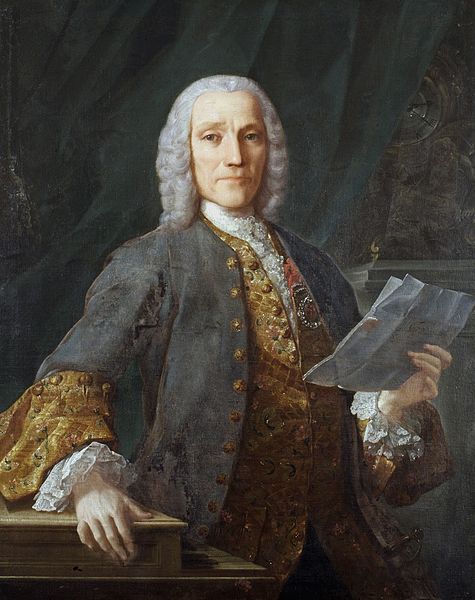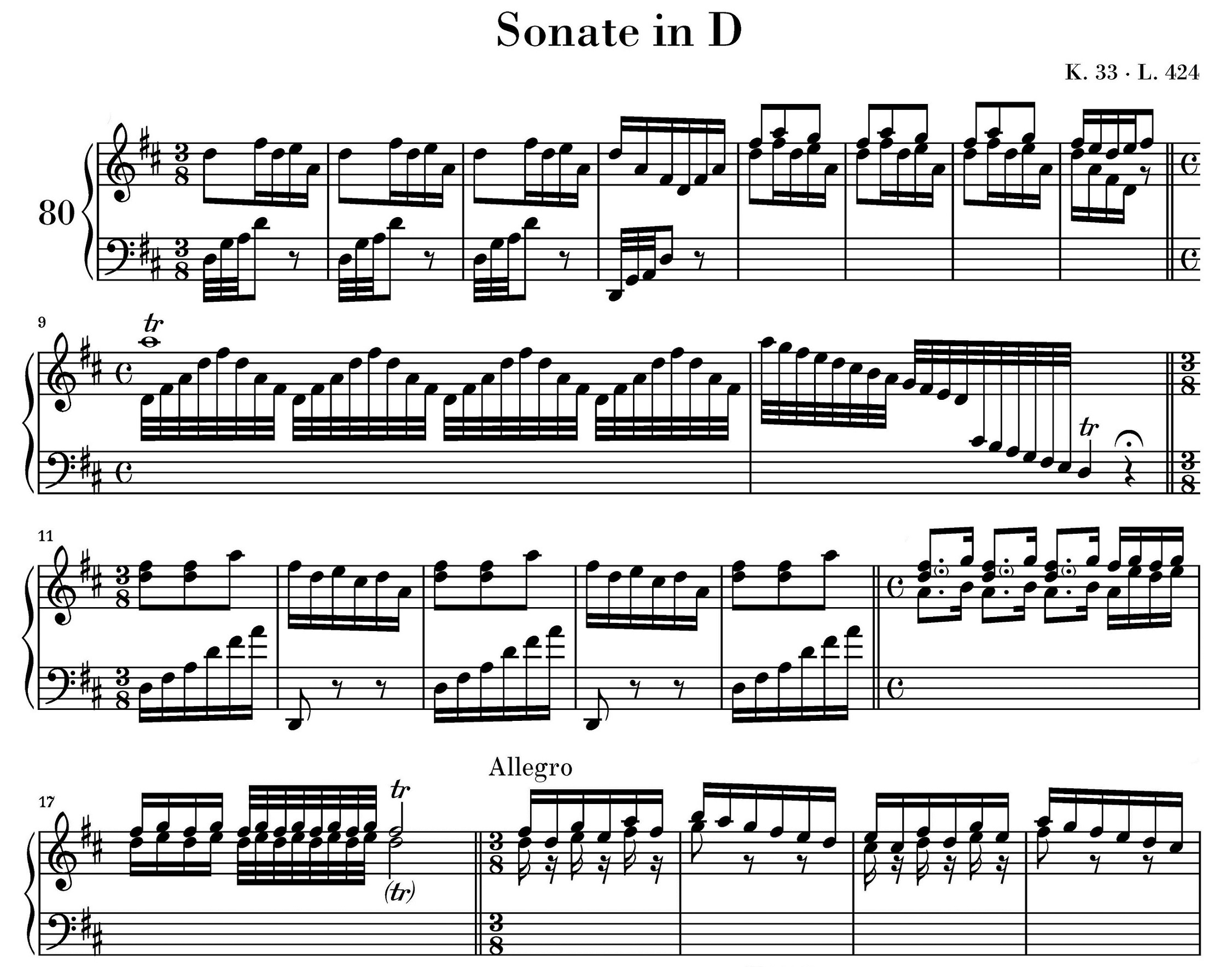Though Domenico Scarlatti (1685–1757) was indeed born the same year as Bach and Handel, he occupies an exceptional position amongst Baroque composers. Playing his harpsichord music is a seemingly carefree joy: virtuosic, sensuous in sound and so not at all cerebral. Scarlatti himself turned to musicians with the following words in a printed edition: “Whether you be dilettante or connoisseur, seek not profundity in these compositions but rather artistic ingenuity and delight with the object of exercising freedom on the gravicembalo.“ The Gravicembalo is the harpsichord – and yet it is astonishing that Scarlatti’s music really sounds so good on the modern concert grand. All great pianists have offered proof of this, with Vladimir Horowitz leading the way:
http://www.youtube.com/watch?v=Q29VWNd4RMo
Obviously then Scarlatti is not absent from the Henle catalogue. Three volumes of Scarlatti sonatas appeared in 1985–1992 (HN 395, 451, 476). They really are something absolutely special: Well-known works side by side with curiosities – there are even four first editions in volume I! For all those who only want to deal in repertoire “winners”, we are meanwhile offering separate editions of the following sonatas: K. 9, K. 141, K. 159, K. 380.
However, since many pianists might miss their favourite sonatas in our three-volume selection, the Henle editorial staff has already long since been pursuing plans to publish a fourth volume, a “Best of Scarlatti”. Pianists were polled beforehand and CD playlists ploughed through; the process of selecting from the sheer fund of over 550 sonatas was not easy. We managed, though, to assemble a volume of the 32 most popular sonatas, an ultimate choice to effectively round out our Scarlatti list.
If the preliminary work was already tricky, then the edition itself was even more so. Scarlatti sonatas have come down to us in a confusing number of sources, primarily manuscripts – though not a single autograph amongst them. Known perhaps to a larger public are the splendid manuscripts from Venice and Parma (Scarlatti sources are always named after their present repository locations). They originated within the composer’s immediate milieu and so have special significance. Extant beyond these are numerous collective and individual manuscripts. First prints from England and France that were evidently authorised augment the large source inventory. It is therefore no wonder that some of the sonatas in our volume are extant in nine sources.
Nine sources – that would be easy to manage if clear-cut relationships could be established amongst the sources themselves. That way some copies could be successfully excluded as not editorially relevant. And, in fact, repeatedly detected traces of transmission can permit source grouping. Nevertheless, each one of these sources contains variants often found only there, whose provenance cannot be explained. That Scarlatti was not involved in these variants cannot normally be proven. So, the multitude of possibly authentic variants must be documented. We are doing this – as already in volumes I–III – with the aid of a detailed footnoting apparatus. However, we have always been able to decide on a main source for the actual music text of every sonata.
Two especially striking examples should representatively illustrate here the abundance of variants in Scarlatti’s sonatas.
The g-minor sonata K. 8 is extant in 7 sources. The differences amongst the sources are great enough to even suggest two versions of the same sonata. Four sources (amongst them, the important print “Essercizi” and the Münster copy) transmit version 1, two sources (amongst them, the French print by Boivin) transmit version 2. The English edition by Roseingrave, astonishingly enough, presents both versions. The second version is headed l’istesso Allegro. Differente. So there is no doubt that both versions were already circulating in Scarlatti’s lifetime (Roseingrave’s edition appeared in 1739). Therefore, we too present the g-minor sonata in two variants. A glance at the 1st line of music makes the difference clear – rhythmically here, especially.
http://www.youtube.com/watch?v=jSFhOnzp5os
The numerous readings for the virtuosic D-major sonata K. 33 are extant in altogether 8 sources. That the introduction (mm. 1–17) can be found in only two sources is particularly striking; the remaining six sources begin with m. 18.
And even with respect to the introductory 17 measures, the two sources are at odds. The music text shown above comes from the main source, the Venice copy. Above m. 16 in the print by Boivin is Largo, on the other hand, and contained here and in the subsequent measures of the lower staff are the notes: ![]()
These two examples may suffice to illustrate the complicated source situation for the Scarlatti sonatas. What, on the one hand, puzzles editors of our day, reveals, on the other, something of the status of this music in 18th century Europe. The great number of contemporary sources gives evidence of the large circulation of Scarlatti’s sonatas – the variants suggest beyond this a living performance practice. The music was dealt with creatively, subject in all likelihood to its composer’s approval. This may absolutely be an incentive and inducement for harpsichordists and pianists of our day!





Good news, but – with respect – please stop messing about and produce a complete edition.
A reasonably priced full Scarlatti edition should be a basic human right. We deserve better than Longo, and Heugel prices are just ridiculous.
Thank you for your comment. This is an excellent way to put it, a “basic human right”. I agree, but on the other hand editing Scarlatti is immensely complicated. A complete edition is a huge project, considering the fact that there are more than 500 pieces to deal with, each of them with an overwhelming amount of sources and different readings. I am afraid in the near future there will not be a complete Scarlatti edition by Henle Verlag – sorry about that!
Hello – when will this be available in the shops (here in the UK)? I am eagerly awaiting!
Thanks – Bart
Dear Bart,
the volume will be available by August. I hope this helps! If you have further questions, please feel free to get back to me.
Norbert
Thanks for this! After working for years on photocopies downloaded from ISMLP, I found great joy in purchasing this past June the 4 volumes of Scarlatti Sonatas you edited.
I found out , to my great surprise that only Vol 4 would contain the Sonatas I would usually prefer to play. Reading your explanation on how VOl 4 wash shaped gives me great joy, as I have plotted in excel the occurrences of Scarlatti’s Sonatas in Playlists of famous pianists, and then in Kirkpatricks and Longo books, to realize there is almost no match and that preference is – with Scarlatti – an evolving taste for individual jewels, all shiny in particular moments. So, I laughed and marveled our approached was so similar, and that a person in distant Kuwait, like me, was spending mornings at deciphering a way to select her preferred Scarlatti’s Sonatas, while you were (surely much more skillfully) something quite similar at your place, years ago.
I want to end my comment assuring you my admiration for your editions, and my agreement with the availability to the 50 sonatas of Scarlatti be elevated to a basic and necessary Human Right.
Be happy,
Maria Angela Capello
Hi. Its true that is complicated to publish Scarlatti’s 555 sonatas due to the difficulty of the sources; However, it would be wonderful if Henle published in a single book (and a clothbound perhaps) an Urtext version of the first 30 sonatas under the title “Essercizi per gravicembalo” taken directly from Scarlatti’s publication.
It would be great and it is not very difficult for you.
Greetings from Mexico!.
Hello, thank you for your comment. I have to admit: That is a nice idea, indeed! However, we’d prefer to stay confident to our principle of collected volumes (and single editions) and not to “confuse” this by publishing new units/collections according to the sources (even though the “Essercizi” represent one of the most important Scarlatti sources…). Thank you for your understanding. Greetings to Mexico!